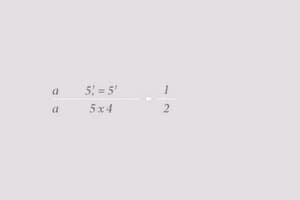Podcast
Questions and Answers
What is the formula for the width of each subinterval in a Riemann sum?
What is the formula for the width of each subinterval in a Riemann sum?
- ∆x = (b + a) / n
- ∆x = (b - a) / n (correct)
- ∆x = (b - a) * n
- ∆x = (a - b) / n
Under what condition is the definite integral ∫_a^b f(x) dx negative?
Under what condition is the definite integral ∫_a^b f(x) dx negative?
- When f(x) is positive over [a, b]
- When both a and b are negative
- When the area under f(x) lies below the x-axis (correct)
- When the area under f(x) lies above the x-axis
Which of the following represents the correct parametrization of a circle centered at (a, b) with radius R?
Which of the following represents the correct parametrization of a circle centered at (a, b) with radius R?
- r:[0,2π]→ R^2, r(t) = (cos(t), sin(t))
- r:[0,2π]→ R^2, r(t) = (Rcos(t), Rsin(t))
- r:[0,2π]→ R, r(t) = (a + bcos(t), Rsin(t))
- r:[0,2π]→ R^2, r(t) = (a + Rcos(t), b + Rsin(t)) (correct)
What distinguishes a boundary point in the context of a domain in R^2?
What distinguishes a boundary point in the context of a domain in R^2?
Given the expression ∫_a^b x^2 dx, how would you compute this integral if a is non-zero?
Given the expression ∫_a^b x^2 dx, how would you compute this integral if a is non-zero?
When evaluating the definite integral ∫_1^c f(x) dx where c is a vertical asymptote, what must be done?
When evaluating the definite integral ∫_1^c f(x) dx where c is a vertical asymptote, what must be done?
What is the general form of the parametric equation for a line segment connecting points v1 and v2 in R^n?
What is the general form of the parametric equation for a line segment connecting points v1 and v2 in R^n?
What is the first step in finding the equation of the tangent to a curve at a given point?
What is the first step in finding the equation of the tangent to a curve at a given point?
Flashcards
Definite Integral
Definite Integral
The integral of a function f(x) from a to b, represented as ∫_a^b f(x) dx.
Riemann Sum
Riemann Sum
An approximation of the integral by partitioning the interval into n subintervals and summing areas of rectangles.
Parametrization of a Curve
Parametrization of a Curve
Expressing a curve as a function r(t), where t is the parameter for coordinates in R^2 or R^3.
Equation of Tangent Line
Equation of Tangent Line
Signup and view all the flashcards
Interior Point
Interior Point
Signup and view all the flashcards
Boundary Point
Boundary Point
Signup and view all the flashcards
Open Set
Open Set
Signup and view all the flashcards
Closed Set
Closed Set
Signup and view all the flashcards
Study Notes
Definite Integrals
- Riemann Sum: A method to approximate the area under a curve.
- Formula: A = lim┬(n→∞)∑_(k=1)^n▒〖f(x_k )*∆x〗.
- ∆x = (b-a)/n (width of each rectangle)
- x_k = a + k∆x (x-coordinate of k-th rectangle)
- For a = 0, the specific case is ∫0^b▒〖f(x) dx= lim┬(n→∞)∑(k=1)^n▒〖f(kb/n)*b/n〗 〗 .
- For general a, to calculate ∫_a^b▒〖x^2 dx〗 : ∫_a^b▒〖x^2 dx〗= ∫_0^b▒〖x^2 dx〗-∫_0^a▒〖x^2 dx〗.
Properties of Definite Integrals
- Negative Area: A definite integral is negative if the area under the curve is below the x-axis.
- Convergence of Integrals: ∫_1^∞▒〖1/x^p dx〗 converges for all p > 1. It diverges for p ≤ 1.
Type 2 Integrals (Vertical Asymptotes)
- Integration with Asymptotes: If an asymptote is within the bounds of the integral:
- ∫_1^c▒〖f(x) dx〗 = lim┬(b→c^- )∫_1^b▒〖f(x) dx〗
- ∫_c^1▒〖f(x) dx〗 = lim┬(b→c^+ )∫_a^1▒〖f(x) dx〗 (a is a value before c on the graph).
Parametrization
-
Parametric Curves: Curve y = f(x) on interval [a,b] is represented as r(t) = (t, f(t))
-
Lines: Line through points v1, v2 in R^n: r(t) = v1 + t(v2 - v1).
-
Line Segments: r(t), 0 ≤ t ≤ 1, from v1 to v2.
-
Circles:
- Center (0,0), Radius R: r(t) = (Rcos(t), Rsin(t)) (0 ≤ t ≤ 2π).
- Center (a,b), Radius R: r(t) = (a + Rcos(t), b + Rsin(t)) (0 ≤ t ≤ 2π).
- Variations: Upper semicircle (0 ≤ t ≤ π), right semicircle, traversing twice, clockwise, etc.
- e.g., Circle Traversed Twice: r:[0, 4π] → R^2
-
Tangent Line: Steps for finding the tangent line to a parametrized curve r(t) at (x0, y0):
- Calculate r'(t).
- Find t0 such that r(t0) = (x0, y0).
- The tangent's direction vector is r'(t0).
- Calculate the slope from the direction vector and use the point-slope form to find the equation of tangent line.
Functions of Two (or Three) Variables
- Domain: Set of (x, y) pairs where f(x, y) is defined.
- Interior/Boundary Points: Interior: points contained within a disk entirely inside the domain. Boundary: points on the edge.
- Open/Closed Domains: Open: All points are interior. Closed: Includes boundary points.
- Bounded/Unbounded Domains: Bounded: Doesn't reach infinity.
- Image: Range of values z resulting from the function.
- Contour Curves/Level Sets: Collection of points on the graph with constant z-value. This forms a curve or set of points on the graph of the function.
Studying That Suits You
Use AI to generate personalized quizzes and flashcards to suit your learning preferences.




